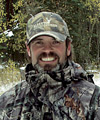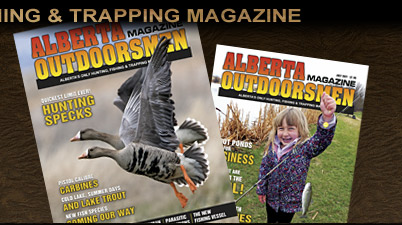|
 |
 |
The letter was clearly written with repugnance to an article in the Alberta Farmer magazine and later re-written and published in the Calgary Herald with the title, “If elk could talk, they’d choose to die on hunt farms.”
In fact, Alberta Outdoorsmen subscriber, Frank Kacsinko, the author of the letter addressed to me and dated April 22, 2011, appeared clearly upset, ending his letter with comments that certainly can’t be published within this magazine.
The article in question was composed by Alberta Farmer editor, Will Verboven, regarding controversial Bill 11, the Livestock Industry Diversification Amendment Act.
Verboven took issue with the “good old boys” of the Alberta Fish and Game Association (AFGA) for sounding the “conspiracy alarm” that Bill 11 would open the door to hunt farms in Alberta.
Claiming that hunt farms “are a legitimate way to market domestic elk and should be encouraged and not banned by government.”
Verboven then claims to be perplexed by the anti-hunt farm position, suggesting that if elk were given the choice they would choose a quick death on a hunt farm as opposed to “being relentlessly chased by hunters (perhaps on quads and accompanied by hunting dogs), being shot at a long distance with laser-directed high-powered rifles, perhaps being only wounded and left to die a horrible slow death and even being disemboweled alive by opportunistic predators.”
Verboven then suggests he may be exaggerating but quickly revokes that by making the comparison again.
His next argument for hunt farms comes with the claim that hunt farms will create more opportunities for “fair chase” hunters by taking some of the hunters out of the wild and putting them onto hunt farms, thereby “increasing the number of available wild elk.”
Then Verboven ends his article theorizing that the AFGA, being a member of the Alberta Conservation Association, which “receives a checkoff portion of the hunting licences issued annually in Alberta”, deems hunt farms as a “potential threat to that income.”
Captured in the middle of the page and boxed off is Verboven’s suspicion that “...unofficially, Minister Hayden and every previous agriculture minister since 2002 knows the prohibition of hunt farms in Alberta is unfair and unwarranted.”
Surely much of Verboven’s article must have been written in jest, because clearly it could be easily dismissed as nonsensical diatribe.
Or, shockingly, is his view shared by a misinformed group that view organizations like the AFGA, and a massive general public, as being naive to game farming and the inherent risks associated with it?
Is it so easy to brush off the game farm bovine tuberculosis outbreak of 1990 that in turn afflicted humans that were exposed to infected domesticated elk, and cost Canada its TB-free status valued by Agriculture Canada at $1 billion?
As written in The Lancet, November 16, 1991 by Dr. E. Anne Fanning, MD, FRCPC. “Of 81 contacts who were skin-test positive, 50 had been in contact with culture-positive animals. 6 of 106 subjects tested a second time became tuberculin positive.”
Is it also easy to forget that the Expert Scientific Panel on Chronic Wasting Disease confirmed that the source of Canada’s CWD was “spillover from infected game farms?”
That to date there has been 114 cases of CWD confirmed in wild deer in Alberta, and as of 2010, 311 deer and 3 elk in Saskatchewan, caused by that same spillover.
That as of February 1, 2011, 64 cervid farms have been infected with CWD in Canada. That there are currently seven farms under quarantine in Saskatchewan and 12 farms have been declared “highly contaminated premises” and are under permanent quarantine.
Is it also so easy to forget that the privatization and commercialization of wildlife is a direct threat to public wildlife and the economies they provide?
According to Canada’s National Wildlife Disease Strategy, “Economic activity based on wildlife is very large in Canada. A study in 1996 demonstrated that such activity contributed $12.1 billion to the Canadian GDP in that year, equivalent to the $12.3 billion that was the total contribution to the GDP by all of agriculture.”
It would be safe to surmise that the game farming contribution would have been but a miniscule component of the $12.3 billion contributed by all of agriculture.
And even far less today.
Moreover, the game farming industry is failing, even after being supported with taxpayer dollars at the whim of a government that ignores its own “precautionary principle” enshrined in the 1999 Canadian
Environmental Protection Act (CEPA 1999).
Which states that, “...where there are threats of serious or irreversible damage, lack of full scientific certainty shall not be used as a reason for postponing cost-effective measures to prevent environmental degradation.”
Would this statement in itself not include the end to a game farming industry that most certainly hasn’t demonstrated full scientific certainty that its actions do not create “threats of serious or irreversible damage” to the environment, and our public wildlife?
And lest we forget that game farming goes against the very policies that led to the North American Model of Wildlife Conservation (read Don Meredith on page 20), proclaiming wildlife to be held in the public trust and although an individual may own the land upon which wildlife resides, that individual does not own said wildlife. Instead, all citizens own the wildlife.
In the words of Darrel Rowledge, author of the excellent book No Accident, “Clearly no rational, objective person would continue to support (and have taxpayers subsidize) reckless and utterly uneconomic ventures... in complete disregard of all costs, damage, threats or implications for the future.”
Unless your name is, Will Verboven. ■
For previous Outdoor Pursuits click here.
|
|
|
|


